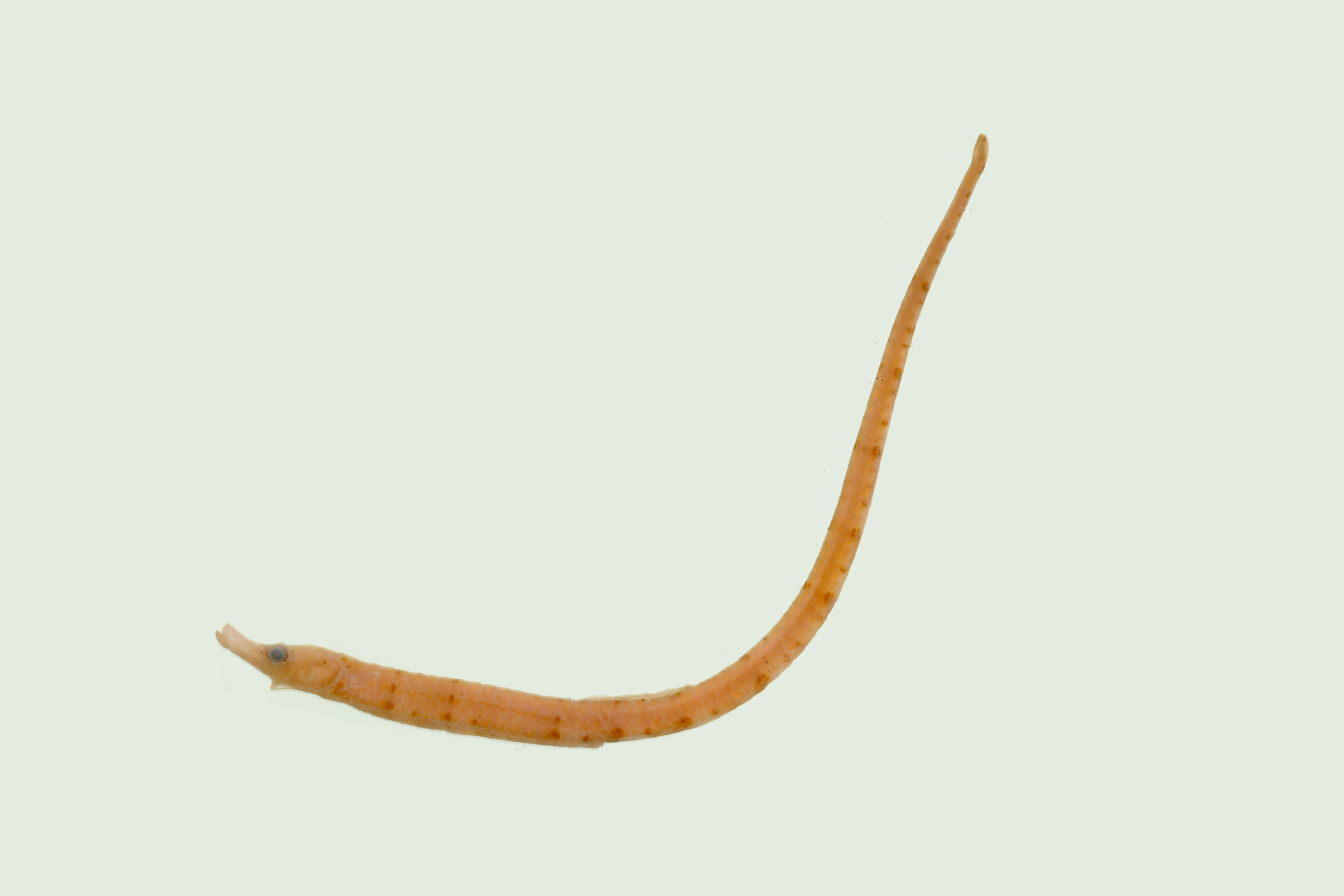Trawl Pipefish, Kimblaeus bassensis Dawson 1980

Holotype of Kimblaeus bassensis. Source: David Staples / Museum Victoria. License: CC BY Attribution
The Trawl Pipefish, the only species in the genus Kimblaeus, is only known from a few specimens taken in dredges on rubble or shelly bottomed substrates. Body orange with a few darker orange spots on the head and broad brownish-orange bands on body.
Trawl Pipefish, Kimblaeus bassensis Dawson 1980
More Info
|
Distribution |
Endemic to temperate waters of Southern Australia, from off Nowra, NSW and eastern Tasmania to Port Lincoln, South Australia. Inhabits rubble and shelly substrates on the continental shelf at 10-204 m. |
|
Features |
Distinguished by the presence of dorsal and pectoral fins in adults, an eight-rayed caudal fin. confluent lateral trunk and Meristic features: Dorsal fin 25-27; Pectoral fin 9-10; Caudal fin 8; Trunk rings 17-18; Tail rings 44-46. Body elongated, trunk shallow; head aligned with body; snout of moderate length, 40-48% head length; snout depth 28-40% snout length; opercular ridge angled upward towards gill opening, poorly defined or obscure in adults; small dermal flaps usually on head; superior trunk ridge and superior tail ridge continuous; inferior trunk ridge and inferior tail ridge discontinuous; lateral trunk ridge deflected ventrally below front of dorsal fin and confluent with inferior tail ridge. Dorsal fin slightly closer to head than to tip of tail, base of moderate length; anal fin absent; caudal fin small, rounded. |
|
Size |
Reaches 165 mm SL. |
|
Colour |
Orange with a few dark orange spots on head and broad brownish orange bands on body, each band 3-5 rings wide and separated by space of 1-2 rings. |
|
Feeding |
Unknown - likely to feed on small crustaceans. |
|
Biology |
Males brood the developing eggs in an enclosed pouch on the underside of the tail just behind the anus. The only known brooding male is 160 mm SL. The larvae have not been described. |
|
Fisheries |
Although taken as bycatch in scallop dredges, the Trawl Pipefish is of no interest to fisheries or agriculture. |
|
Conservation |
Australian Commonwealth Government legislation: Marine listed under the Environment Protection and Biodiversity Conservation Act 1999 (EPBC Act). State Government Legislation: Listed as protected under the Victorian, Tasmanian and South Australian Fisheries Management Acts. |
|
Remarks |
Known only from a few specimens, most dredged in commercial scallop grounds. |
|
Similar Species |
Kimblaeus is a monotypic genus endemic to southern Australia with no close relatives in Australian waters. |
|
Etymology |
The generic name Kimblaeus is for H.M.A.S. "Kimbla", the vessel that trawled one of the type specimens. The specific name bassensis refers to the Bass Strait origin of the paratype. |
|
Species Citation |
Kimblaeus bassensis Dawson 1980, Aust. J. Mar. Freshwat. Res. 31(4): 518, figs. 1-2, Tasman Sea, Victoria. |
|
Author |
Thompson, Vanessa J. & Dianne J. Bray |
Trawl Pipefish, Kimblaeus bassensis Dawson 1980
References
Kuiter, R.H. 2009. Seahorses and their relatives. Aquatic Photographics, Seaford, Australia. Pp. 1–333.
Paxton, J.R., J.E. Gates, D.F. Hoese & D.J. Bray. 2006. Syngnathidae (Pp. 810–846). In Beesley, P.L. & Wells, A. (Eds) Zoological Catalogue of Australia. Volume 35. Fishes. ABRS & CSIRO Publishing, Australia., 3 vols.
Pogonoski, J.J., D.A. Pollard & J.R. Paxton. 2002. Conservation Overview and Action Plan for Australian Threatened and Potentially Threatened Marine and Estuarine Fishes, Environment Australia, Canberra. 375 pp.

